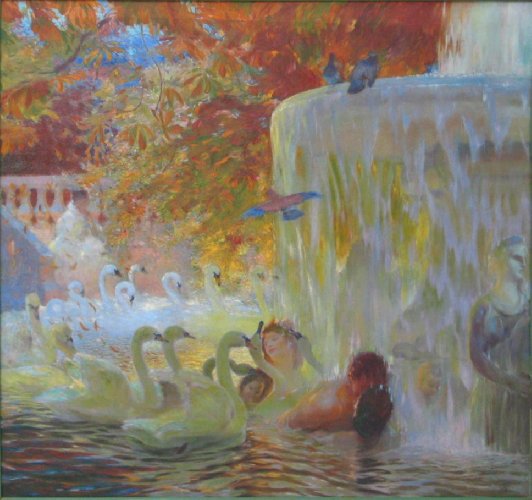Description:
Gaston La Touche (1854-1913) was a French painter. He remained faithful to colourism in his works. He addressed issues related to Brittany. He often referred to motifs taken from the art of the 18th-century rococo. At the initial stage of his creative work, he was inspired by Edward Manet. He also often met with Edgar Degas. He got to know Émile Zola, whose works he later illustrated. He was a member of the Société des Artistes Français and the Société Nationale des Beaux-Arts. The artist was successful. He often exhibited at Salons. He painted decorative, almost theatrical, intimate, fanciful, mythological, genre, numerous melancholic landscapes: night and autumn.
Description of the painting:
“The Fountain of Youth” fully captures the atmosphere of French rococo. It refers to the symbolism of fountains popular in art since the 16th century, as well as to the often occurring motif of a swan. In this view, the mystery of eternal youth is hidden in the constantly renewing circle of life and beauty. The young, full of vitality figures of adults and children placed in the pond are opposed to the eternal law of passing away. In La Touche’s painting, it is shown under the curtain of autumn captured in the park. The colourful leaves falling from the trees cover everything. They become a sign of passing time. The only way to circumvent its law is the constantly recu
And what if we oppose the merciless and eternal law of passing away? Cross the boundaries of human possibilities and find the mythical source of immortality? This is one of the few aspects of life over which man has not been allowed to reign. Once expelled from the heavenly Paradise for breaking the rules, he wanders the world looking for a way back. In the lost kingdom of eternal youth and happiness, there was supposed to be the Tree of Life and the miraculous source flowing from it.
Water, whether it was an unbridled river, a calm stream, a vibrant source, or a fountain, in many beliefs became a place of meetings with divine powers. It was a symbol of rebirth and renewal. A sign of immortality and perfection as the “water of life”, “the source of youth”. In Christian symbolism, God is the “Fountain of the Living Water” giving eternal life, and immersion in water or pouring it carries with it a transformation not of the body, but of the spirit. Herodotus in “Histories” writes about a lake located in Africa, whose waters gave the body a characteristic glow and scent of violets. It was also said about the kingdom of the mysterious priest John, in which at the foot of the tree there was a miraculous source. The water of it restored youth and protected from plague. The Spanish monarch herself financed expeditions of the fountain of eternal youth searchers *.
On La Touche’s painting, this fountain was found. It is located in the park. Ornamented with a stone balustrade, the stairs lead to it. But viewers are not the first to have noticed this ancient relic. Already a nude couple embracing and kissing and a girl with children are bathing in it. In the background we see autumn, golden trees. The falling leaves from them evoke reflection on the inevitable passing of time. They freely immerse themselves in the waters of the fountain. They fall on the beaks of swans swimming in it. White, extraordinary birds are symbols of beauty, perfection, purity and grace, but – importantly in the context of La Touche


